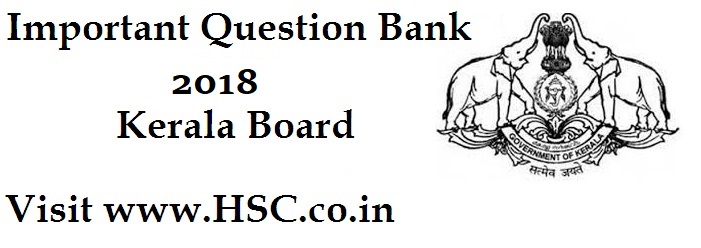HSC Board Exams are fast approaching and students are getting anxious about how to prepare for their HSC Board Exams. So we had mentioned some HSC Study Tips to help students in Cracking HSC Exams.
After the tremendous success of our last year Important Questions Bank for Kerala Board (+2) Board Exam 2016 and Important Question Bank for Kerala Board (+2) HSE (HSC) Board Exam 2017 we have also created a list of Most Important Question Bank for Kerala Board (+2) HSE (HSC) Board Exam 2018 which are likely to appear in HSC Board Exams this year.

To unlock the content Click on any of 3 buttons available in the box below saying “This content is Locked”. Once you click on the button the content will get unlocked on same page itself. You must click on social media button showing in below box ie Facebook, Twitter or Google Plus to unlock the content.
Hi, we’re trying to collate and gather the data and would be updating it here a few days before the exam. Please keep on visiting our website for updates.
Please use the comments box below and post questions that you think are important from your analysis. It would help the HSC community a lot.
Do subscribe to our updates so that you do not miss out on any important information that we push your way.
1. One gram atom of an element contains 6.023 ×
(a) Find the number oxygen atoms in 4 g of O2.
(b) Which is heavier, one oxygen atom or 10 hydrogen atoms?
2. Quantum numbers give the address of an electron. Explain all the four quantum numbers.
3. A cation is smaller than the corresponding neutral atom while an anion is larger. Justify.
4. Water is liquid while H2S is a gas
(a) Suggest the reason for the above fact
(b) Explain the phenomenon.
(c) Mention any two facts based on the above phenomenon.
5. What are the two types of hard water?
6. What is the reason for hardness of water?
7. Suggest one method for remove hardness of water.
8. Q and w are not state functions, but ( q + w ) is a state function why ?
9. What do you mean by saying that pressure is an intensive property.
10. What is the difference in internal energy or a system, if 100kJ of energy is radiated out without doing any work?
11. 10 g of an organic substance is dissolved in two liters of water at 280 K. Find out the mooar mass of the substance if osmotic pressure of the solution is 0.059 atmospheres.
12. A compound is formed between oxygen and fluorine. Do you know whether it is oxygen fluoride or fluorine oxide? Explain.
13. What is a homogeneous series?
14. Explain the significance of octane number in grading petrol.
15. Write down the name of an antiknocking agent used in petrol.
16. What is the corresponding for measuring efficiency of diesel?
17. How you can separate the following mixtures?
(a) Napthalene, Urea
(b) Anthralene, Benzoic acid
(c) Chloroform, Aniline
(d) Water, kerosene
18. ‘Use of DDT pollutes the environment.’ Justify.
19. What is paramagnetic property and ferromagnetic property?
20. A compound is formed by two elements P and Q atoms of Q (as anions) make hcp lattice and those of the element P ( as cations) occupy all the tetrahedral voids. What is the formula of the compound?
21. What is osmotic pressure?
22. Molecular mass of NaCl determined by osmotic pressure measurement is found to be half of the actual value. Account for it.
23.Write one similarity and one difference between antiseptics and disinfectants.
24. Calculate the osmotic pressure exerted by a solution prepared by dissolving 1.5 g of a polymer of mass 185000 in 500 ml of water at 37°C [R = 0.0821 L ATM
25. Daniel cell is primary cell whole lead storage cell is a secondary cell. Write any one differencebetween primary cells and secondary cells.
26. Establish the significance of '(a+b)' and '(x+y)' in terms of order and molecularity.
27. Write any two differences between order and molecularity.
28. “reactions with zero order is possible, but zero molecularity is not”. Justify the statement.
29. Write any four differences between lyophilic sold and lyophobic sols.
30. Peptisation is a method of preparation of sols write a general procedure for peptisation.
31. Calcination and roasting are pre treatments in metallurgy before metal extraction differentiate between calcination and roasting.
32. Describe haber process for the manufacture of ammonia. Describe contract process for the manufacture of sulphuric acid.
33. How will you account for the colour of potassium dichromate crystals?
34. Write the IUPAC name of the above coordination compound.
35. Write the formula of the ionisation isomer of the above. Compound.
36. How do orbitals split in an octahedral Crystal Field?
37. Draw a diagram which indicate the splitting if orbital in tetrahedral field.
38. Arrange the four isomeric bromo butanes in the increasing order of their reactivity towards Sn1 reaction.
39. How will you prepare chlorobenzene from benzene diazonium chloride?
40. How will you prepare the following compounds using grignard reagent?
(a) Primary alcohol
(b) Secondary alcohol
41. How will you distinguish primary and secondary alcohol using Lucas test?
42. Write the correct pair of reactants for the preparation of t-butyl ethyl ether by Williamson synthesis.
43. What is aldol condensation reaction?
44. Write the structural formula of aldol formed from ethanal.
45. Write a method of preparation of primary amines.
46. Describe a chemical reaction given only by primary amines.
47. What is diazotisation?
48. Write any two differences between step growth polymerisation and chain growth polymerisation.
49. What are the monomers of the following
(a) Neoprene
(b) Nylon – 6
Don’t forget to read : MUST REMEMBER THINGS on the day of Exam for HSC Students
Best of luck for your exams. Do leave a comment below if you have any questions or suggestions.
